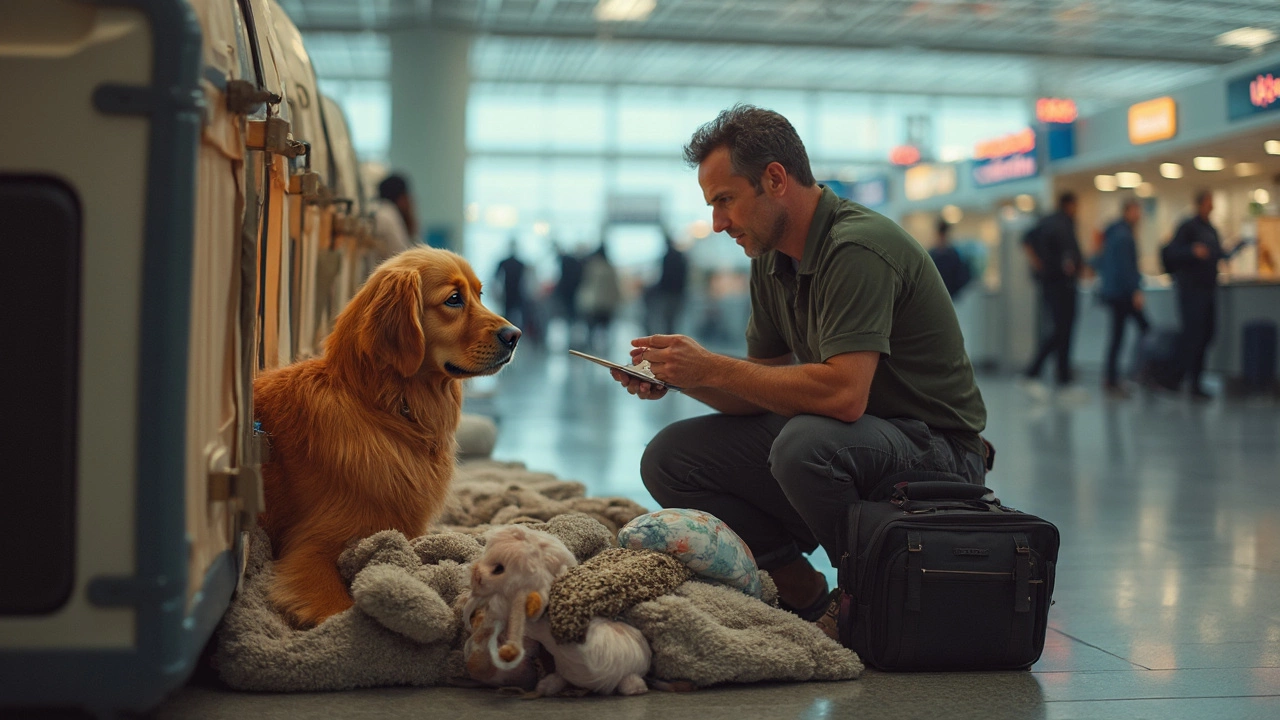Ever wondered if it's safe to fly your dog in cargo? You're not alone. Many pet owners face this dilemma, especially when long-distance travel is unavoidable. While flying in cargo isn't always a walk in the park for our furry friends, it can be done safely with the right prep and knowledge.
First thing's first, it's crucial to understand the risks and concerns. Cargo holds are designed to carry a variety of things, and while they're climate-controlled, they can still be noisy and sometimes unsettling for pets. Not all animals react the same, so knowing your dog's temperament is key. Some dogs might take it in stride, while others might find it stressful.
Before you book that flight, check the airline regulations. They vary widely, and some airlines have specific requirements or restrictions for pet travel. Make sure your dog's health records are up to date. A visit to the vet for a travel health check is a good idea, ensuring your dog is fit to fly and has all necessary vaccinations.
- The Risks and Concerns of Cargo Travel
- Preparing Your Dog for the Flight
- Navigating Airline Regulations
- Post-Flight Care and Tips
The Risks and Concerns of Cargo Travel
Flying in cargo can be a daunting experience for dogs, and it's important to weigh the risks before making a decision. While airlines have improved the conditions for pets traveling this way, there are still issues to consider.
Temperature and Environment
While cargo holds are generally climate-controlled, they might not always match the comfort of the passenger cabin. It's crucial to fly your dog with an airline known for good pet transport practices, especially if you're traveling in peak summer or winter months. Temperature fluctuations can be stressful and sometimes harmful to pets.
Handling and Noise
The cargo area can be considerably noisier due to engines and other equipment. This could be distressing, especially for dogs not used to loud sounds. Moreover, the handling process—loading and unloading—needs to be smooth to avoid scaring your pet or causing injury.
Stress Levels
Just like people, dogs have different stress levels. Some might thrive in new environments, while others could become anxious. Assess your dog's personality thoroughly; it can make a significant difference in how they handle the journey.
Health and Safety Concerns
Before flying, make sure your pet is healthy. Dogs with respiratory problems or certain breeds like brachycephalic (short-nosed) dogs might be at higher risk. A pre-flight checkup with your vet can help you understand any specific travel risks for your dog.
For greater peace of mind, research is key. Know your airline's track record and speak with them about their specific pet policies. In addition, ensure the carrier is airline-approved, sturdy, and comfortable for your dog, providing ample room to stand, turn, and lie down.
Preparing Your Dog for the Flight
Getting your furry friend ready to fly isn't just about packing their favorite toy. There's a bit more planning involved to make sure your dog has a smooth journey. Let's walk through some steps that can make a big difference.
Crate Training
Selecting the right crate is essential. The crate needs to be IATA-approved and spacious enough for your dog to stand, turn around, and lie down comfortably. Familiarize your dog with this space well before travel day. You can start by encouraging them to spend time in the crate during normal days at home, maybe with a treat or two.
Health Check
Before flying, a visit to the vet is necessary. Ensure your dog is up-to-date on vaccinations and gets a clean bill of health. Vets can point out anything that might make air travel risky, like respiratory issues common with certain breeds. If your pet is especially anxious, the vet might suggest a mild sedative to keep them calm.'
Getting Them Comfortable
Try to maintain a normal routine leading up to the flight. Feed your dog as usual but avoid feeding them right before traveling; a light meal about 4 to 5 hours before departure works best. Exercise your dog before heading to the airport to help them relax later on.
Checklist for Travel Day
- Dog collar with ID tags – Essential for identification.
- Extra leash – You never know when it might come in handy.
- Favorite blanket or toy – Comforts your dog during flight.
- Water bottle & bowl – Hydration is important.
Don't forget to label the crate with your dog’s name, your contact info, and any special instructions in case of emergency.
Keep Them Calm
Using a pheromone spray or diffuser in the crate can help calm your pup. Additionally, some quiet play before the flight can ease their minds.
A stress-free dog is a happy flying companion, after all!

Navigating Airline Regulations
So, you're planning to fly with your dog in cargo, but where do you start with all these airline regulations? It's like decoding a maze sometimes, but no worries, I've got your back and I'll walk you through it.
First off, it's important to know that each airline is different. They have their own sets of rules when it comes to pet safety and travel. Here’s the deal: most major airlines do allow dogs in cargo, but they have specific guidelines that you need to follow.
Check the Airline’s Pet Policy
Start by visiting the airline's website or giving them a quick ring to get the lowdown on their pet policies. Look for things like crate size requirements, any breed restrictions, and the allowed number of pets per flight. Always double-check because these rules can sometimes change.
Understand Health and Documentation Needs
A visit to the vet isn't just a good idea; it's usually required. Most airlines demand a health certificate issued within 10 days of travel. Make sure your dog is up-to-date with all their shots and isn’t facing any major health issues.
Consider Seasonal Restrictions
Believe it or not, some airlines have restrictions when it comes to seasonal travel for dogs in cargo. This usually happens during extreme weather conditions — think sweltering summer heat or freezing winter temperatures. It’s all about keeping your pet safe.
Invest in an Airline-Approved Crate
The right crate is super important for your dog's comfort and safety. Airlines typically have detailed specifications, so make sure to follow them closely. The crate should be well-ventilated, solid, and big enough for your dog to stand, turn, and lie down comfortably.
Fees and Additional Costs
Yep, flying your dog in cargo isn’t usually free. Airlines charge extra fees for pet travel, and they vary depending on the airline and destination. Keep an eye on your budget as these can add up quickly!
Post-Flight Care and Tips
Your dog has just landed from a cargo flight, and while it's a relief to be on solid ground, the journey doesn't end here. The way you handle those first few hours after the flight can make a big difference in easing your pet's transition.
Checking Your Dog
First off, check your dog for any signs of distress or injury. Pay attention to their behavior and body language. It’s not uncommon for dogs to be a bit out of sorts after a long flight.
"Always give your pet a few hours to settle down after travel," advises Dr. Emily Thomas, a well-known veterinarian. "Some discomfort is normal, but watch for anything unusual like persistent lethargy or vomiting."
Hydration and Feeding
Make sure your dog has access to plenty of water as flying can dehydrate them. Wait for about an hour or two before offering a regular meal, giving their stomach a chance to settle. Gradually introduce small amounts of food if they're up for it.
Re-establishing Routine
- Return to their normal routine as quickly as possible, including regular walks and feeding times.
- If your dog is crate-trained, let them rest in their travel crate for comfort.
- Provide their favorite toys or blanket to help them relax.
Consistency and familiarity will help your dog adjust faster to the new location.
Encouraging Exercise
Once your dog seems to be back to normal, encourage them to get some exercise. A walk around the new neighborhood can help burn off pent-up energy and offer new sights and smells to explore, helping them adapt to their new surroundings quicker.
If possible, choose pet-friendly accommodations or areas that offer safe spaces for dogs to roam. This becomes even more crucial for trips lasting longer than a couple of days.

